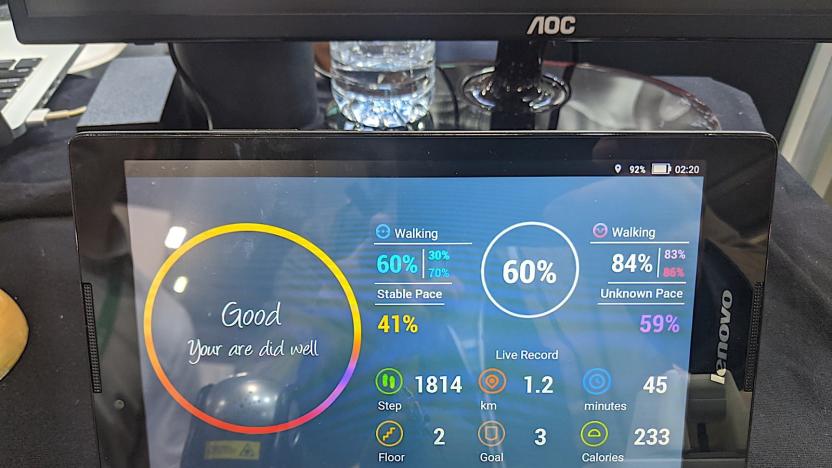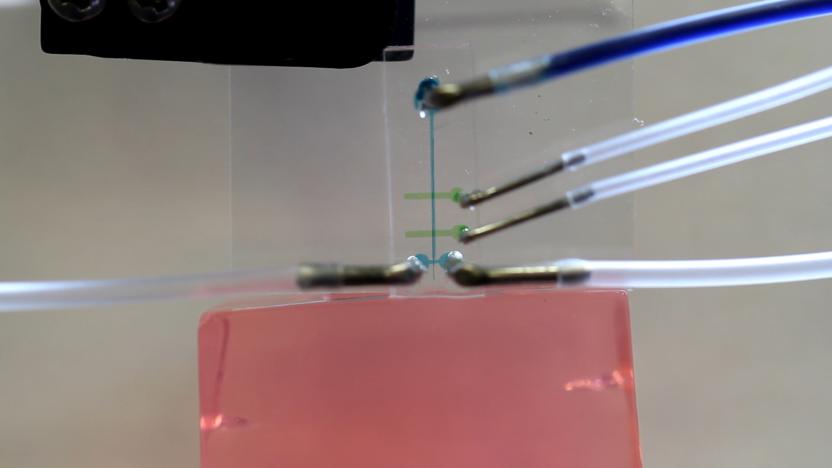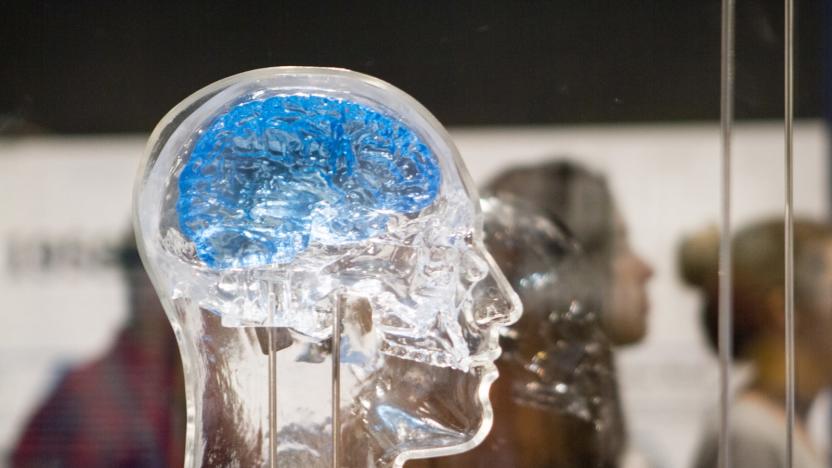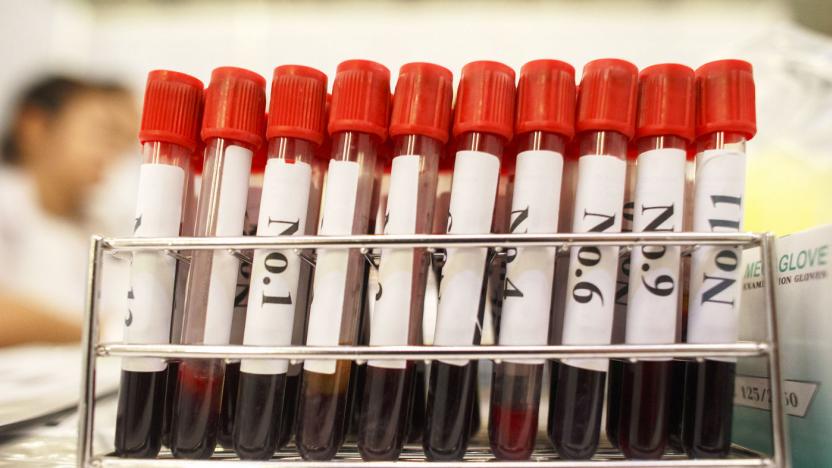ParkinsonsDisease
Latest

This laser aid helps Parkinson's patients maintain their mobility
Sixty-thousand Americans are diagnosed with Parkinson's Disease each year. The progressive nervous system disorder impacts the body's motor neurons causing tremors, slowing and stiffening of limb movements, and a halting walking gate. While there is no cure for the disease, a number of treatment options are available. One such example is the Exobeam from Hong Kong's Medexo Robotics.

IBM fingernail sensor tracks health through your grip
The strength of your grip can frequently be a good indicator of your health, and not just for clearly linked diseases like Parkinson's -- it can gauge your cognitive abilities and even your heart health. To that end, IBM has developed a fingernail sensor that can detect your grip strength and use AI to provide insights. The device uses an array of strain gauges to detect the deformation of your nail as you grab objects, with enough subtlety to detect tasks like opening a pill bottle, turning a key or even writing with your finger.

Apple Watch can now be used to monitor Parkinson’s symptoms
Apple has added a new API to its ResearchKit framework that will allow apps to monitor Watch users for signs of Parkinson's disease, 9to5Mac reports. The API will be able to track two symptoms associated with the movement disorder -- tremors and dyskinesia -- continuously throughout the day. Apps monitoring these two activities would then be able to display the recorded data, showing instances of the symptoms per day, hour or minute.

Researchers create less invasive method for placing brain electrodes
Our neurons are firing all the time, receiving signals from other neurons and sending signals of their own. To get a better understanding of how the brain works, scientists often listen in to those signals to see what kind of messages certain neurons send and how often they send them. Doing that often requires researchers to implant an electrode into the brain, which when it's close enough to a neuron, can pick up on the electrical signals that propagate through the neuron. However, getting an electrode into the brain isn't so easy. They either have to be rigid enough to penetrate the brain and remain straight or be inserted through needles that can keep them straight until they're safely in place. The problem is those rigid structures cause damage as they move through the brain and minimizing that damage is a goal that scientists are constantly working towards.

Brain mapping could lead to better Parkinson's treatments
When you repair electronics, you frequently test individual parts to see how they affect the whole. Why not try that with the brain? Stanford is doing just that. It developed a technique that fires specific kinds of neurons to map the brain and identify problems caused by Parkinson's and other diseases. The approach first uses optogenetics to make neurons activate in response to light, and follows up with a functional MRI scan to look for the increased blood flow that indicates activity in other brain regions. A computational analysis maps that particular neural circuit and helps determine its role.

Nike's power-laced Mags net millions for Parkinson's research
All the nostalgia around Nike's self-lacing shoe, the 2016 Mag, came together in a major way for a great cause. Today, the sportswear titan revealed it raised $6.75 million through its online raffle and two auctions, with all proceeds going to The Michael J. Fox Foundation. The money, as a refresher, will help the organization try to find a cure for Parkinson's disease. Michael J. Fox, who starred in the Back to the Future II film that made the sneakers popular, suffers from Parkinson's himself.

Researchers have engineered monkeys with Parkinson's disease
Scientists in Japan have successfully bred a set of genetically modified marmosets with Parkinson's disease, Alzheimer's disease and motor neurone (Lou Gehrig's) disease, The New Scientist reports today. The development could lead to major breakthroughs in the treatment of neurological disorders.

Australian researchers developed a blood test for Parkinson's
By the time Parkinson's disease makes itself known in humans, it's already too late for treatment. But La Trobe University in Australia has developed a test that detects a biomarker present in blood cells in folks with the disease. The school describes the test as a means of detecting problems within cell mitochondria that cause an energy-and-stress-sensing protein, dubbed AMPK, to permanently activate and start damaging cells.

Apple's CareKit helps patients better manage their illnesses
During its "Loop You In" event today, Apple revealed a new way for people -- and their doctors -- to better manage their health. Building off of its successful ResearchKit program, the company debuted CareKit, what Apple COO Jeff Williams described as "a framework to build apps that empower people to use data to understand their health."

ICYMI: Cockroach torture, an app for Parkinson's and more
#fivemin-widget-blogsmith-image-567613{display:none;} .cke_show_borders #fivemin-widget-blogsmith-image-567613, #postcontentcontainer #fivemin-widget-blogsmith-image-567613{width:570px;display:block;} try{document.getElementById("fivemin-widget-blogsmith-image-567613").style.display="none";}catch(e){} Today on In Case You Missed It: A cybernetic cockroach how-to describes how to use an Arduino to control where a cockroach goes, which makes all of us uncomfortable.

Doctors breach the blood-brain barrier for the first time
Our blood-brain barrier is a highly selective membrane specially designed to only allow very specific molecules access to our grey matter while keeping everything else out -- regardless of whether they're invading foreign bodies or potentially life-saving medicines. That's no longer the case. Doctors from Toronto's Sunnybrook Hospital have recently managed to temporarily jiggle the barrier open using directed ultrasonic waves and keep it open long enough to deliver chemotherapy drugs.

Nanowire technology will improve brain-stimulating implants
Scientists at Lund University have published a paper about a new nanowire thread (only 80 nanometres in diameter) that will work to strengthen brain implants. Neuro-prostheses are currently used to stimulate and collect information from the brain of those with Parkinson's disease, along with other illnesses. However, one of the biggest problems that current tech faces is that the brain identifies the implant as a foreign object and uses cellular material to surround the electrode, resulting in a loss of signal. With the newly developed technology, this will (hopefully) no longer be the case.

Computer keyboards could detect early-stage Parkinson's disease
It's tough identifying Parkinson's disease in its early stages -- there are no standard lab tests to diagnose it and symptoms are subtle. A group of MIT researchers believe the answer could lie in something a lot of people already use: the computer keyboard. They've recently conducted a study proving that people with conditions affecting motor function have different typing patterns than those who don't. To be exact, the researchers designed plug-in software to measure how long subjects pressed each key before releasing it. Those with impaired motor skills ended up pressing keys for a longer duration.

Michael J. Fox Foundation uses wearables for Parkinson's research
In order to collect data from patients, the Michael J. Fox Foundation for Parkinson's Research (MJFF) has teamed up with Intel to leverage the tech company's tracking prowess. The effort employs Intel's big data analytics platform to comb through stats collected by wearable devices that monitor symptoms. A "multiphase study" will gather data from patients in order to inform drug research and development. Rather than depending on written journals, wearable devices can gather info on slowness of movement, severity of tremors and sleep quality 24 hours a day. The duo also has a mobile app in the works that will add the ability for patients to input their medications and how they're feeling as addition details for researchers.

Nike unveils the 2011 MAG shoe, to auction off 1500 pairs of the coolest kicks in Hill Valley for charity
You remember the first time you saw Back to the Future II, don't you? We all dreamed of a world filled with hoverboards and self-lacing shoes, and now Nike's made the latter a reality... sort of. Marty McFly's favorite high tops are now called the 2011 Nike MAGs and look just like the kicks in the movie, though it appears that you'll have to lace 'em up the old-fashioned way. They'll only be on sale during a ten-day period starting tonight at 8:30PM Pacific Standard Time, and no amount of flux-capacitation can score you a pair if you miss that window. 150 sets of shoes will be auctioned on eBay's Fashion Vault each day (sorry, US bidders only), and all the net proceeds will go to The Michael J. Fox Foundation to further Parkinson's research. Not only that, all the money made will be doubled through matching contributions. Nice job, Nike, now about those hoverboards...

European Parkinson's patients receive first Libra DBS implants to help alleviate symptoms
St. Jude Medical's announced that patients from Austria, Germany, and Greece are among the first to be implanted with Libra Deep Brain Stimulation (DBS) devices to alleviate the symptoms of advanced Parkinson's Disease. Specifically, it's able to reduce akinesia, rigidity, tremor, and motor complications associated with taking levodopa.The company's touting Libra and LibraXP as having the longest-lasting battery of any DBS in their class, meaning potentially less surgical procedures needed for for when they gotta be replaced. No word on when they'll be expanding use of the device, but we're sure it's coming.[Via Medgadget]









